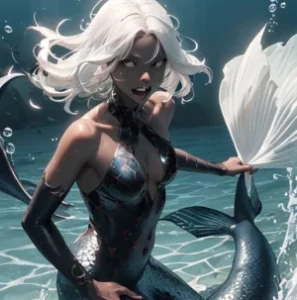
The Dark History of Mermaids
Once upon a time, a little mermaid trades her voice for human legs. She has a few troubles along her journey but has a happily ever after with her prince charming in the end.
At least, that’s what Hollywood is telling us.
Ariel is Dead
We’re all familiar with the story.
The innocent mermaid makes a deal with a wicked old witch and has to convince a prince to kiss her in three days’ time. She fails, but then an action-packed ending plays out. Resulting in her magically getting what she’s always wanted.
It’s the major impression of mermaids in today’s culture. It’s in shows books and movies. But it all sprouts from the kid-friendly retelling of a cruel fairy tale.
The original story by Hans Christian Anderson tells of a little mermaid who died without love. A sorrowful story of pain and unrequited feelings.
In Han’s story, the little mermaid doesn’t have an identity besides her feelings of longing for her prince. It drives her to make a brash deal. The same deal in the modern film, but with agonizing pain with every step of her legs. Through it all, she managed to find her prince.
Cruel irony strikes when the prince reveals he fell in love with the girl who found him on the beach. His heart didn’t belong to her, and never would. Her loyal sisters make a deal, and the witch makes a coral knife to kill the prince. She can’t go through with it, and instead casts herself into the sea, her body turning into sea foam.
This story of grief, changed significantly to be family-friendly. But both the original tale and the modern story have paved the way for today’s view of mermaids. Original stories and myths were buried beneath centuries of time and songs sung by a crab.
Our 21st-century view of mermaids is vastly different from the sirens every smart sailor feared. If the beautiful ladies with glittering tails we see in media today aren’t correct, then what are they really?
The First Mermaid
Only one character in The Little Mermaid was true to his original self.
Triton.
There’s a problem with this because he is not a mermaid. Triton is historically the son of the Greek god Poseidon. He has the lower half of a fish and the top half of a man. This is the inspiration for the mermaids in Hans’ story. Yet, Triton is a demigod of the sea and not a representation of mermaid kind.
So what do mermaids really look like?
Centuries ago, long before Rome was built and Greek mythology existed, the ancient Assyrians worshiped a deity by the name of Atargatis. She was connected with the sea and adored all the creatures that lived in the waters.
Legend has it that she fell in love with a human man. She talked to him, despite being a goddess and a human. However, their affection grew, and their relationship blossomed. What Atargatis didn’t know, was that sleeping with him would kill him. She took no caution and was grieved when his death was caused by her.
Realizing she was with child, she waited in mourning to give birth.
As soon as she had the baby, she threw herself into the sea in hopes of death.
The other gods loved her and thought she was too beautiful to die. So, they transformed her into a fish so she could be with her ocean friends.
Very close to the story of The Little Mermaid.
A young beautiful woman whose forbidden love caused her to throw herself into the sea.
Whether or not the tale of Atargatis was inspiration for Han’s tale, the goddess herself was passed down through many cultures.
Sirens
The ancient Greeks caught hold of the tale of Atargatis, but not in the way one would think. Atargatis was their inspiration for Aphrodite, the goddess of beauty. Homer, one of the foundations of Greek mythology, writes of Sirens in his works. They are half women, and half, well, bird.
“…the island of the Sirens, those creatures who spellbind any man alive, whoever comes their way. Whoever draws too close, off guard, and catches the Sirens’ voices in the air— no sailing home for him…”
In Greek mythology, these Sirens used to be connected with the sea. Before they became man-eating beasts, they were nymphs. And not just any nymphs, but Persephone’s handmaidens. When Hades took Persephone to the underworld, Demeter turns the handmaidens into Sirens in anger.
They become part monster and part dangerous woman.
Any passing ship meets a sudden doom. Every sailor who hears their call will steer the ship right into the shallow waters. And the Sirens devour their prey like spiders catching a fly in their web.
Mermaids and sirens intertwine over time until women are a dangerous thing on the waters. Many even believed it was bad luck to have a woman on board a voyage.
They steer away from coves and caves, fearing the sight of a tail and the voice of an angel.
Culture and Mermaids
Ancient Greeks are not the only culture that mixed up their mermaid facts. Unique tales of mermaids are told across the seven seas. Western culture kept the idea of beauty associated with mermaids and ran overboard with it. But mermaids differ in other places, and they differ vastly.
Japanese Mermaids
This is one of the more horrific versions of mermaids. A creature half fish and all monster, known as the ningyo. Which means “fish person”. The Japanese believed that consuming the flesh of a ningyo would grant immortality. The first ningyo was a fisherman who trespassed protected waters. The fisherman was transformed into a fish monster as punishment. He went to Prince Shotoku and asked him to put his mummified body in a temple. Fast forward to modern day, there are dried remains of a mermaid creature in the Tenshou-Kyousha shrine in Fujinomiya. The mummy is cared for personally by the priests there.
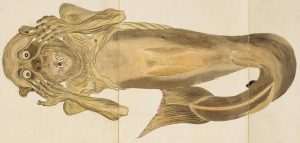
African Mermaids
African mythology has a single mermaid. She has her own exhibit at UCLA. Her name is Mami Wata, and she’s a powerful water goddess. Unlike the Japanese mermaids, Mami Wata is half woman and half fish. She has beauty and charm and is connected to water and anacondas. While the deity herself has no traumatic origins of how she came to be, the ones who speak of her have a dark story. Tales of Mami Wata arose during the transatlantic slave trade. She is the spirit who supposedly protected the captives on their journey across the ocean. Mami Wata was a symbol of hope for those who were suffering.
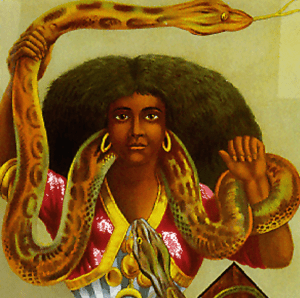
Indian Mermaids
One of the ten incarnations of the Hindu god Vishnu is said to be half man and half fish. In their religion, the first man, Manu, catches a small fish. That fish begins to grow to a giant size until it becomes part man. This avatar of Vishnu is known as Matsya. Although he is an important figure in Hinduism, he is not found in many stories and none like him exist in the culture.
Sirens reappear, though, in multiple religions across India. They are known as the Naga, but the females are called Nagi. The Nagi is a new type of siren, and they do not look like the women birds in ancient Greece, but instead are half-woman and half-cobra. They are guardians of water and killers of men, seducing and singing for their next meal.
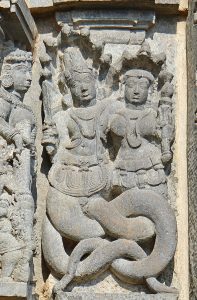
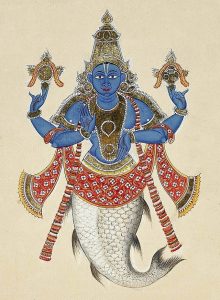
Slavic and Russian Mermaids
Rusalka are water spirits of drowned women who wander in search of vengeance. They wear gowns made of mist and have voices that drip with honey. The rusalki of Russia are repulsive and violent. They ambush humans and stalk through the night with pond water dripping from their oily hair. Slavic mythology describes Rusalki oppositely, they are charming and bewitching. Despite the differences between the two cultures’ descriptions, they have a similarity. That similarity is enchanting men and luring them in for a kill. There is a week called Rusalki Week at the beginning of summer. This is when the women leave their waters and dance in the moonlight. Any man who is unfortunate enough to see them will join them and dance until he dies.
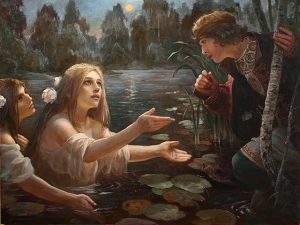
European Mermaids
British sailors have a strong fear that mermaids will bring a ship down and drown all the men. Pirates and navy men alike thought of mermaids as beautiful creatures who lured ships in with their voices.
However, on land, it’s a different story. A famous icon seen in every American town today comes from an old European folklore. Many are holding her in their hand as they drink their pumpkin spice lattes. Melusine is a certain two-tailed mermaid and was one of the few kinder mermaids in folklore.
Her mother cursed her to become part water serpent every Saturday. If she did not find a man who loved her but did not look upon her on Saturdays, she would become a serpent permanently. Melusine found such a man and made a happy life with him. They had children and lived normally. But eventually, her husband became fed up with her strange habit. He sent someone to spy on her on a Saturday. The man saw her in her cursed form, and in shock, she jumped out the window and swam away. From that day, she was a serpent forever.
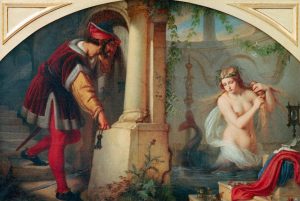
The Blurry Reality of Mermaids
Manatees have been blamed for the origins of mermaids, but with such a rich history, the chances that mermaids came from somewhere else are higher. What were people seeing that made these stories be told over and over again? Could there be some truth to tales of siren calls? Perhaps dark creatures swim in the unexplored depths of the seas, waiting for a ship to pass overhead.
Author – Levi F.
Sources:
https://drive.google.com/file/d/13ihnuBb8GiN2oQ1zSapK4qiLqo7AvaBk/view?usp=sharing
Great Article!